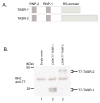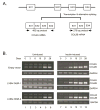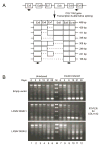TASR-1 regulates alternative splicing of collagen genes in chondrogenic cells
- PMID: 17367759
- PMCID: PMC1887518
- DOI: 10.1016/j.bbrc.2007.02.159
TASR-1 regulates alternative splicing of collagen genes in chondrogenic cells
Abstract
During the differentiation of chondroprogenitors into mature chondrocytes, the alternative splicing of collagen genes switches from longer isoforms to shorter ones. To investigate the underlying mechanisms, we infected mouse ATDC5 chondroprogenitor cells with retrovirus for stable expression of two closely related SR splicing factors. RT-PCR analysis revealed that TASR-1, but not TASR-2, influenced alternative splicing of type II and type XI collagens in ATDC5 cells. The effect of TASR-1 on splicing could be reversed with the addition of insulin. Results from our microarray analysis of ATDC5 cells showed that TASR-1 and TASR-2 differentially affect genes involved in the differentiation of chondrocytes. Of special interest is the finding that TASR-1 could down-regulate expression of type X collagen, a hallmark of hypertrophic chondrocytes. Immunohistostaining demonstrated that TASR-1 protein is more abundantly expressed than TASR-2 in mouse articular chondrocytes, raising the possibility that TASR-1 might be involved in phenotype maintenance of articular chondrocytes.
Figures




Similar articles
-
Proper expression of helix-loop-helix protein Id2 is important to chondrogenic differentiation of ATDC5 cells.Biochem J. 2009 May 1;419(3):635-43. doi: 10.1042/BJ20081715. Biochem J. 2009. PMID: 19175360
-
Paracrine and autocrine signals promoting full chondrogenic differentiation of a mesoblastic cell line.J Bone Miner Res. 2004 Jan;19(1):100-10. doi: 10.1359/JBMR.0301206. J Bone Miner Res. 2004. PMID: 14753742
-
New target genes for NOV/CCN3 in chondrocytes: TGF-beta2 and type X collagen.J Bone Miner Res. 2005 Dec;20(12):2213-23. doi: 10.1359/JBMR.050818. Epub 2005 Aug 22. J Bone Miner Res. 2005. PMID: 16294274
-
Alternative splicing of type II procollagen: IIB or not IIB?Connect Tissue Res. 2014 Jun;55(3):165-76. doi: 10.3109/03008207.2014.908860. Epub 2014 Apr 18. Connect Tissue Res. 2014. PMID: 24669942 Free PMC article. Review.
-
Splicing regulation: the cell cycle connection.Curr Biol. 2003 Feb 18;13(4):R149-51. doi: 10.1016/s0960-9822(03)00079-4. Curr Biol. 2003. PMID: 12593819 Review.
Cited by
-
Viral Interferon Regulatory Factor 1 of Kaposi's Sarcoma-Associated Herpesvirus Interacts with a Translocation Liposarcoma Protein-Associated Serine-Arginine Protein.Osong Public Health Res Perspect. 2012 Mar;3(1):8-13. doi: 10.1016/j.phrp.2012.01.001. Osong Public Health Res Perspect. 2012. PMID: 24159480 Free PMC article.
-
BMP-2 and TGF-beta1 differentially control expression of type II procollagen and alpha 10 and alpha 11 integrins in mouse chondrocytes.Eur J Cell Biol. 2010 Apr;89(4):307-14. doi: 10.1016/j.ejcb.2009.10.018. Epub 2010 Feb 2. Eur J Cell Biol. 2010. PMID: 20129696 Free PMC article.
-
Identification of SRSF10 as a regulator of SMN2 ISS-N1.Hum Mutat. 2021 Mar;42(3):246-260. doi: 10.1002/humu.24149. Epub 2020 Dec 16. Hum Mutat. 2021. PMID: 33300159 Free PMC article.
References
-
- Kronenberg HM. Developmental regulation of the growth plate. Nature. 2003;423:332–336. - PubMed
-
- McAlinden A, Havlioglu N, Sandell LJ. Regulation of protein diversity by alternative pre-mRNA splicing with specific focus on chondrogenesis. Birth Defects Res C Embryo Today. 2004;72:51–68. - PubMed
-
- Ryan MC, Sandell LJ. Differential expression of a cysteine-rich domain in the amino-terminal propeptide of type II (cartilage) procollagen by alternative splicing of mRNA. J Biol Chem. 1990;265:10334–10339. - PubMed
-
- Hatano H, Sarkar G, Bolander ME. Development of a cellular model to study alternative splicing of type II collagen gene. J Orthop Res. 2002;20:516–519. - PubMed
-
- Nishiyama T, Hatano H, Kurosaka M, Bolander ME, Sarkar G. Cis-acting intronic elements that regulate cartilage-specific alternative splicing of the type II collagen (Col2) pre-mRNA lie at or near splice site junction sequences flanking exon 2 of the gene. J Bone Miner Res. 2003;18:1716–1722. - PubMed
Publication types
MeSH terms
Substances
Grants and funding
LinkOut - more resources
Full Text Sources
Research Materials

